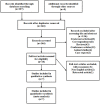Effect of continuous positive airway pressure on carotid intima-media thickness in patients with obstructive sleep apnea: A meta-analysis
- PMID: 28863162
- PMCID: PMC5580911
- DOI: 10.1371/journal.pone.0184293
Effect of continuous positive airway pressure on carotid intima-media thickness in patients with obstructive sleep apnea: A meta-analysis
Abstract
Objective: Obstructive sleep apnea (OSA) is associated with increased carotid intima-media thickness (IMT), an early marker of atherosclerosis. Continuous positive airway pressure (CPAP) is the first-line treatment for OSA. A meta-analysis was performed to determine whether CPAP therapy could decrease carotid IMT.
Methods: The PubMed, Embase, Web of Science, and Cochrane library were searched before March, 2017. Weighted mean difference (WMD) was calculated to estimate the treatment effects of pre and post-CPAP therapy. Seven studies were examined and the meta-analysis was performed using STATA 12.0.
Results: There was no change of carotid IMT before and after CPAP treatment in OSA patients (WMD = 0.052, 95% confidence interval (CI) = -0.002 to 0.105, z = 1.90, p = 0.057). Meanwhile, meta-analysis of the two RCTs showed that carotid IMT was not changed in CPAP group when compared with control group (WMD = 0.002 95% CI = -0.125 to 0.129, z = 0.03, p = 0.976). Subgroup analyses indicated that carotid IMT was significantly decreased after CPAP use in more severe OSA patients (AHI≥50) (WMD = 0.073, 95% CI = 0.022 to 0.124, z = 2.80, p = 0.005) and patients with therapeutic duration ≥6 months (WMD = 0.121, 95% CI = 0.019 to 0.223, z = 2.32, p = 0.021).
Conclusions: CPAP had no impact on carotid IMT in OSA patients. However, carotid IMT was significantly decreased after CPAP treatment in more severe OSA patients and patients with longer CPAP usage.
Conflict of interest statement
Figures





Similar articles
-
Effects of CPAP therapy on visceral fat thickness, carotid intima-media thickness and adipokines in patients with obstructive sleep apnoea.Respirology. 2017 May;22(4):786-792. doi: 10.1111/resp.12963. Epub 2016 Dec 9. Respirology. 2017. PMID: 27933703 Clinical Trial.
-
[Long-term effects of continuous positive airway pressure treatment on subclinical atherosclerosis in obstructive sleep apnoea syndrome].Med Clin (Barc). 2016 Jul 1;147(1):1-6. doi: 10.1016/j.medcli.2016.03.032. Med Clin (Barc). 2016. PMID: 27210810 Spanish.
-
Effect of continuous positive airway pressure on liver enzymes in obstructive sleep apnea: A meta-analysis.Clin Respir J. 2018 Feb;12(2):373-381. doi: 10.1111/crj.12554. Epub 2016 Sep 19. Clin Respir J. 2018. PMID: 27614004 Review.
-
Association among plasma interleukin-18 levels, carotid intima- media thickness and severity of obstructive sleep apnea.Chin Med J (Engl). 2009 Jan 5;122(1):24-9. Chin Med J (Engl). 2009. PMID: 19187612
-
Impact of continuous positive airway pressure on vascular endothelial growth factor in patients with obstructive sleep apnea: a meta-analysis.Sleep Breath. 2019 Mar;23(1):5-12. doi: 10.1007/s11325-018-1660-4. Epub 2018 Apr 18. Sleep Breath. 2019. PMID: 29671205 Review.
Cited by
-
Effectiveness of an intensive weight-loss program for severe OSA in patients undergoing CPAP treatment: a randomized controlled trial.J Clin Sleep Med. 2020 Apr 15;16(4):503-514. doi: 10.5664/jcsm.8252. J Clin Sleep Med. 2020. PMID: 32003737 Free PMC article. Clinical Trial.
-
Sleep Apnea is Associated With Accelerated Vascular Aging: Results From 2 European Community-Based Cohort Studies.J Am Heart Assoc. 2021 Aug 3;10(15):e021318. doi: 10.1161/JAHA.120.021318. Epub 2021 Jul 26. J Am Heart Assoc. 2021. PMID: 34308679 Free PMC article.
-
Predictors for carotid and femoral artery intima-media thickness in a non-diabetic sleep clinic cohort.PLoS One. 2021 Jun 4;16(6):e0252569. doi: 10.1371/journal.pone.0252569. eCollection 2021. PLoS One. 2021. PMID: 34086802 Free PMC article. Clinical Trial.
-
Association between obstructive sleep apnea and 24-h urine protein quantification in patients with hypertension.Sci Rep. 2024 Sep 6;14(1):20876. doi: 10.1038/s41598-024-71883-5. Sci Rep. 2024. PMID: 39242689 Free PMC article.
-
The effects of lateral pharyngoplasty on carotid intima-media thickness in patients with obstructive sleep apnoea.Sleep Sci. 2022 Jan-Mar;15(1):82-87. doi: 10.5935/1984-0063.20220028. Sleep Sci. 2022. PMID: 35662962 Free PMC article.
References
-
- Sleep-related breathing disorders in adults: recommendations for syndrome definition and measurement techniques in clinical research. The Report of an American Academy of Sleep Medicine Task Force. Sleep. 1999;22(5):667–89. Epub 1999/08/18. . - PubMed
-
- Young T, Palta M, Dempsey J, Skatrud J, Weber S, Badr S. The occurrence of sleep-disordered breathing among middle-aged adults. The New England journal of medicine. 1993;328(17):1230–5. Epub 1993/04/29. doi: 10.1056/NEJM199304293281704 . - DOI - PubMed
-
- McNicholas WT, Bonsigore MR. Sleep apnoea as an independent risk factor for cardiovascular disease: current evidence, basic mechanisms and research priorities. The European respiratory journal. 2007;29(1):156–78. Epub 2007/01/02. doi: 10.1183/09031936.00027406 . - DOI - PubMed
-
- Buratti L, Luzzi S, Petrelli C, Baldinelli S, Viticchi G, Provinciali L, et al. Obstructive Sleep Apnea Syndrome: An Emerging Risk Factor for Dementia. CNS & neurological disorders drug targets. 2016;15(6):678–82. Epub 2016/05/18. . - PubMed
-
- Polak JF, Pencina MJ, Pencina KM, O'Donnell CJ, Wolf PA, D'Agostino RB, Sr. Carotid-wall intima-media thickness and cardiovascular events. The New England journal of medicine. 2011;365(3):213–21. Epub 2011/07/22. doi: 10.1056/NEJMoa1012592 ;. - DOI - PMC - PubMed
Publication types
MeSH terms
LinkOut - more resources
Full Text Sources
Other Literature Sources
Medical

